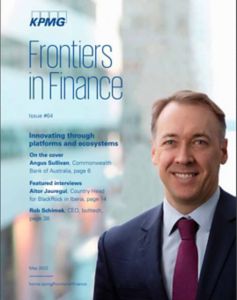For years, the real estate and construction sectors have been slowly ramping up their efforts to innovate. Some have been dipping their toes into pilots and proof of concepts others have been making major steps. While others have been partnering with some of the larger proptechs or testing new construction materials and approaches. Many are looking for ways to more efficiently and effectively manage their ESG ambitions. And some are looking to incorporate available data in operations and/or re-invent property management.
Yet, for the most part, the sector still has a great potential to future embrace innovation.
Breaking the gauge
Over the past few years, however, the pressure to innovate has become intense. Even before the term COVID-19 entered our common vernacular, real estate users, owners, operators, and investors had been pushing for digital transformation and innovation.
Stakeholders were already calling for more ambitious ESG and sustainability targets. Boards and regulators were focusing attention on cyber security and safety. Operators and users were keen to see more data and analytics applied to the user experience and reporting. And everyone was looking for more process agility and robotics to help boost efficiency. The pandemic shattered the pressure gauge.
Consider some of the ways the pandemic impacted the commercial real estate sector, for example. Remote working became the norm, forcing companies to rethink (future) ways of work and their lease arrangements. The need to reduce on-site staff led to the rapid adoption of automation through IoT, sensors and remote monitoring software. Touchless entry systems became ubiquitous in most office buildings. Users’ expectations around health and safety morphed into their views on sustainability and ESG.
Operators and users were keen to see more data and analytics applied to the user experience and reporting. And everyone was looking for more process agility and robotics to help boost efficiency.
Innovating the solution
With the pressure to innovate mounting on all sides, real estate players across the value chain are now putting significant investment into catalyzing innovations in their business and across their ecosystems. In particular, we are seeing four areas capture significant attention — from real estate players and from technology companies and venture capitalists (VCs).
Safety and hygiene. User expectations for building sustainability, health and wellness are creating massive space for new technologies and applications. Wearables and monitoring devices are helping ensure safety and social distancing at job sites and in offices. In some cases, UV-light robots are being introduced to deliver consistent cleaning cycles. Data and analytics are playing an important role — in the optimization of cleaning services, for example, or the identification of potential safety concerns.
Integrating the digital and the physical. In almost every facet of the industry, we are seeing cutting edge technologies like AI, virtual reality and robotics start to change the way people interact with the physical space. In the back office, technology is being used to automate real estate processes. At the front end, new innovations are helping to enhance the customer and user experience, to help optimize the workspace and create new ways for workers and residents to interact virtually with the spaces they lease.
User experience. For developers, property managers, owners and brokerage firms alike, the user experience is shifting from ‘product push’ to ‘client first’ concepts. Data is being collected from right across the asset, allowing deep insight into user expectations and interactions, and allowing developers, property managers and brokerage firms to find and target the right customers. To help support new front-end user interfaces and solutions, we are also seeing growing activity in the areas of data management and compliance.
Construction and architectural innovation. The drive for net-zero carbon buildings is serving as a catalyst for the development of new sustainable building materials. Leveraging cloud-based technologies and remote collaboration solutions, new off-site construction management techniques are spawning creative models and ideas. The widespread adoption of 3D printing and modular construction is creating new opportunities for developers, property managers and technology companies to collaborate and innovate.
Leading banks recognize that sustainability is an issue that requires industry-wide (indeed, financial system-wide) collaboration and response.
Is proptech ready?
Demand for new innovations, solutions and technologies is rising. The good news is that the supply of new and established proptech options is also growing. In KPMG’s recent Real Estate Innovations Overview report (our 6th annual edition), we looked at 42 different countries and territories around the world to find innovations that are aimed at the real estate and construction sector. In the report, we identify 742 companies across 40 different fields of expertise.
There are literally hundreds of technology companies out there, all working to develop innovative solutions for the real estate and construction sector. Now consider this — more than US$23 billion of new capital was invested into proptechs last year alone. While that is down significantly from 2019 numbers, it still suggests a strong appetite for proptech among investors, including corporate and traditional VCs.
From pilot to profit
So, what is stopping real estate and construction players from nurturing and adopting these technologies and innovations? For some less-established players and those with assets particularly hard-hit by the impacts of the pandemic, it comes down to cost. Ultimately, of course, that’s a losing equation — less innovation translates into lower valuations which leads to lower profitability and less room for investing into innovation. It is a deadly cycle.

KPMG’s work suggests there are three broad areas where most real estate and construction players are struggling. The first is in the identification of new ideas and opportunities. In this area, our report provides a comprehensive resource. We have an online tool that allows you to target specific technologies, regions, innovations and value chain components from among the 742 different and unique innovations featured within the report. KPMG firms also work with clients to develop their own ideas, sometimes by challenging their entire organization to crowd-source and collectively enrich new ideas, or by hosting innovation challenges to help collect and test solutions.
The second big challenge is in quickly moving from pilots and proof of concepts to scaled solutions. For the most part, this is about designing a tailored innovation process that fits your organization. It requires new approaches like design thinking, Lean startup and scaled agile. It will also require leaders to patiently bring along their colleagues, create a culture and organizational capability of innovation and inspiring them along the way by helping them experiment with technologies and test new business models while also verifying customer demand.
The third big area where most companies struggle is in turning their investments and solutions into measurable and sustainable value. In part, this is about being able to measure the results of innovation by determining the brand, business and/or cultural value of each project. It also requires leaders to stay on top of the latest trends, technologies and start-ups that are active in their areas and that fit into their innovation strategies. Those on the leading edge may want to focus their ideation efforts on underexposed themes in order to uncover new sources of value.
Time to deliver
The real estate sector had limited disruption and innovation over the past 20 years. But all that is about to change. And it is expected to change quickly. The pressure to innovate is coming from all parts of the value chain: users demand it; regulators are expecting it; investors are rewarding it; operators need it; and property managers and brokers depend on it. Are you doing enough to deliver it?
This article is featured in Frontiers in Finance – Innovating through platforms and ecosystems
Explore other articles ›
Subscribe to receive the latest financial services insights directly to your inbox ›
Connect with us
- Find office locations kpmg.findOfficeLocations
- kpmg.emailUs
- Social media @ KPMG kpmg.socialMedia
Stay up to date with what matters to you
Gain access to personalized content based on your interests by signing up today






